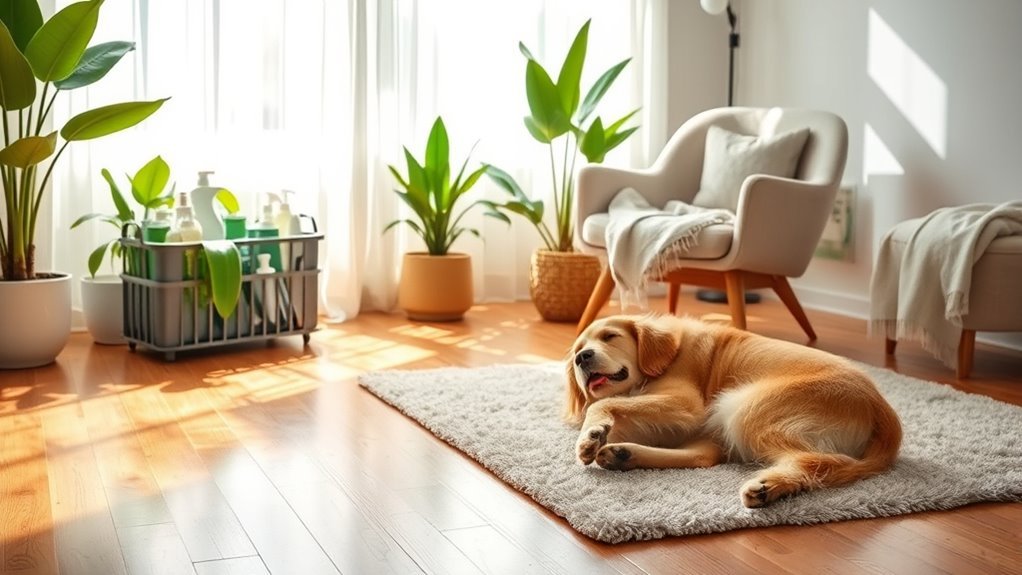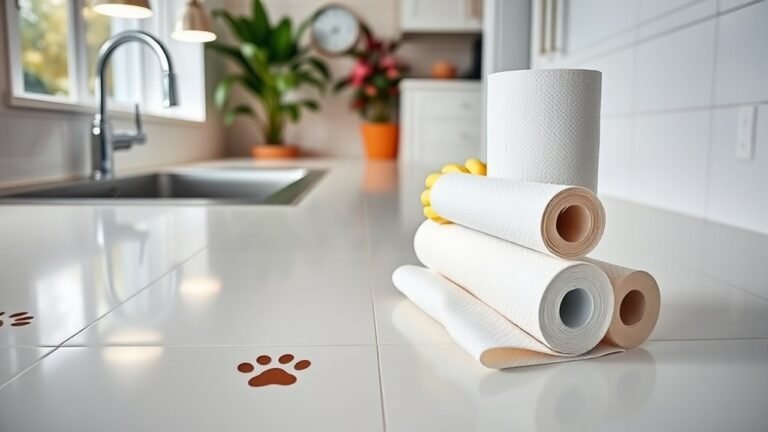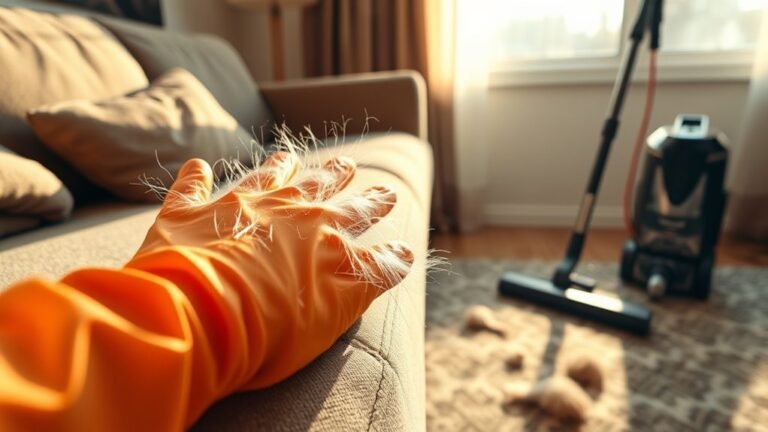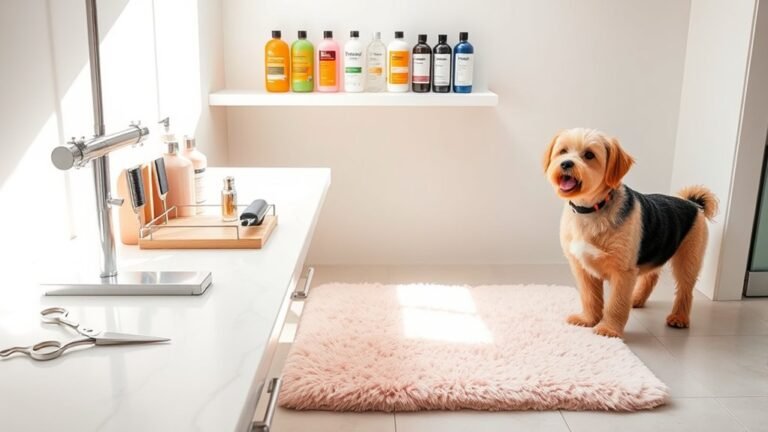Spring Cleaning Guide for Pet Mess
To tackle pet mess this spring, organize your cleaning supplies with pet-safe, non-toxic products like enzymatic cleaners and odor neutralizers. Use rubber gloves, lint rollers, and specialized vacuums to remove hair efficiently. Blot stains quickly, applying cleaners to prevent odors and re-soiling. Maintain litter box hygiene and deodorize rooms with natural methods like baking soda and essential oils. Prioritize safety by avoiding harsh chemicals harmful to pets. With these tips, you’ll create a fresher, healthier home for your furry friends and learn how to manage pet messes easily.
Preparing Your Cleaning Supplies for Pet Mess
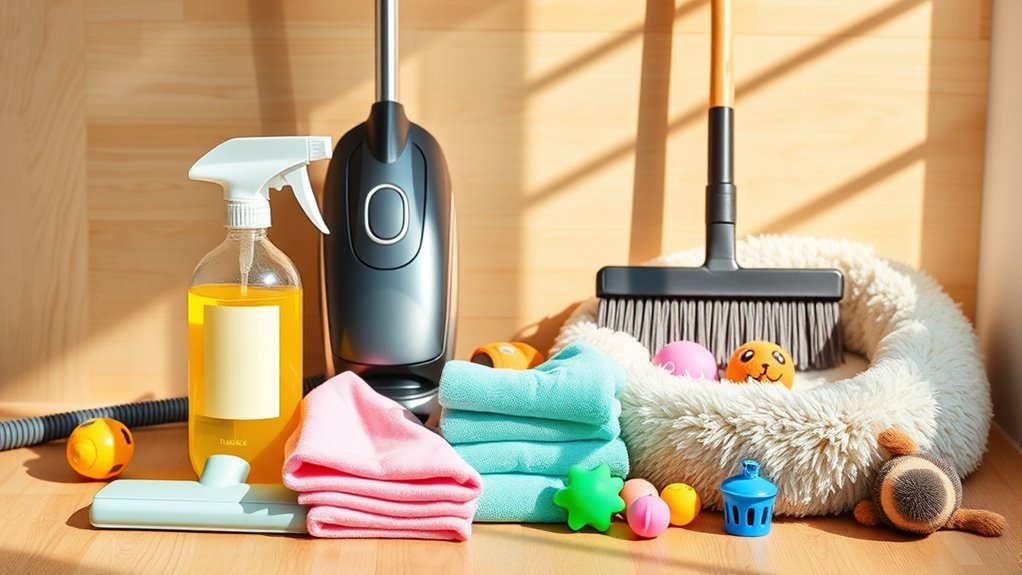
Before you plunge into spring cleaning, it’s crucial to gather the right supplies specifically designed to tackle pet messes effectively. Start by creating a cleaning checklist tailored to your pet’s needs—include enzymatic cleaners, odor neutralizers, disposable gloves, and stain removers. This guarantees you don’t overlook any critical items. Supply organization is key; designate a storage bin or caddy solely for pet-related cleaning products. This way, everything is at your fingertips when you need it, saving you time and hassle. Keeping your cleaning supplies well-organized also helps maintain a clutter-free space, giving you the freedom to clean quickly and efficiently. With the right preparation, you can confidently manage pet messes and enjoy a fresh, inviting home this spring.
Effective Techniques for Removing Pet Hair
You’ll want to arm yourself with the right tools like rubber gloves, lint rollers, and specialized pet hair vacuums to tackle fur effectively. Quick removal tips, such as dampening your hands or using a squeegee on upholstery, can save you time and effort. Let’s explore these methods so you can keep your home fur-free with less hassle.
Best Tools for Hair
Three essential tools can make removing pet hair from your home much easier and more efficient. First, explore vacuum options designed specifically for pet hair; these often feature strong suction and specialized brushes to lift hair from carpets and upholstery effortlessly. Next, keep lint rollers handy—they’re perfect for quick touch-ups on clothing and furniture, easily picking up stray hairs. Finally, consider a rubber broom or pet hair mitt, which attract hair through static electricity, making the cleaning process smoother. Using these tools consistently helps you maintain a hair-free environment, giving you the freedom to enjoy your space without constant worry about pet mess. By choosing the right tools, you’re not just cleaning—you’re reclaiming your home from pet hair with ease and confidence.
Quick Removal Tips
Having the right tools at your disposal is just one part of keeping pet hair under control. To truly master mess management, you need quick tips that fit your busy lifestyle. Start by using a damp rubber glove to gather hair from furniture—it’s simple, effective, and frees you from endless vacuuming. For carpets, a lint roller or static-charged cloth works wonders in lifting stubborn strands. Don’t forget to regularly clean your vacuum filters; clogged filters reduce suction and prolong cleaning time. Finally, establish a daily routine for quick hair removal—just a few minutes can prevent buildup and maintain a fresh space. With these effective techniques, you’ll reclaim your home, enjoying freedom from pet hair without spending hours cleaning.
Tackling Pet Stains on Carpets and Upholstery
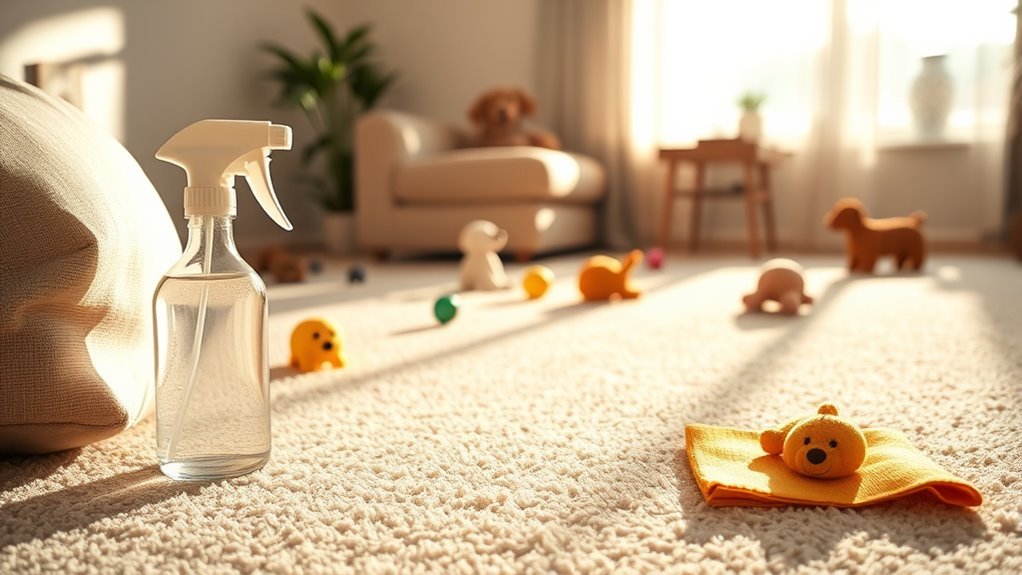
When pet stains appear on your carpets or upholstery, acting quickly is key to preventing lasting damage. You’ll want to use effective stain removers that break down the mess without harming your fabrics. Plus, neutralizing odors guarantees your home stays fresh and inviting after cleaning.
Effective Stain Removal
Dealing with pet stains on carpets and upholstery can feel overwhelming, but you don’t have to tackle it alone. Understanding stain types and removal methods is key to restoring your space quickly and effectively. Here’s how you can take control:
- Identify the stain type—urine, feces, or vomit require different treatments.
- Blot the area immediately with a clean cloth to absorb excess liquid without rubbing.
- Apply an enzymatic cleaner designed for pet stains to break down organic matter and prevent re-soiling.
Odor Neutralizing Tips
Odor is often the most stubborn reminder of pet stains on your carpets and upholstery, but you don’t have to accept it as permanent. You can reclaim fresh, clean spaces by applying effective odor absorption techniques. Start by sprinkling baking soda over the affected area—this natural deodorizing solution is excellent at absorbing smells. Let it sit for at least 30 minutes before vacuuming thoroughly. For deeper odors, mix equal parts white vinegar and water in a spray bottle and lightly mist the area; the vinegar neutralizes odors without harsh chemicals. Remember, prompt action is key. By combining these natural methods, you’ll not only eliminate pet odors but also maintain a safe environment for you and your furry friends. Freedom from persistent smells is within reach when you use these proven odor neutralizing tips.
Deodorizing Your Home to Eliminate Pet Odors
Although pets bring joy and companionship, their presence can sometimes leave lingering smells that are tough to ignore. To reclaim your home’s fresh scent, focus on deodorizing naturally. You can harness the power of natural deodorizing agents and essential oils, which are safe for both you and your furry friends.
Pets enrich our lives but can leave persistent odors; natural deodorizing is a safe, effective way to refresh your home.
Here’s how to effectively deodorize your home:
- Use a diffuser with essential oils like lavender or eucalyptus to neutralize odors.
- Sprinkle baking soda on carpets and upholstery, let it sit for 15 minutes, then vacuum thoroughly.
- Ventilate your space daily to remove trapped smells and bring in fresh air.
These simple steps help you maintain a clean, odor-free environment without harsh chemicals, giving you the freedom to enjoy your home fully.
Cleaning Pet Bedding and Toys Thoroughly
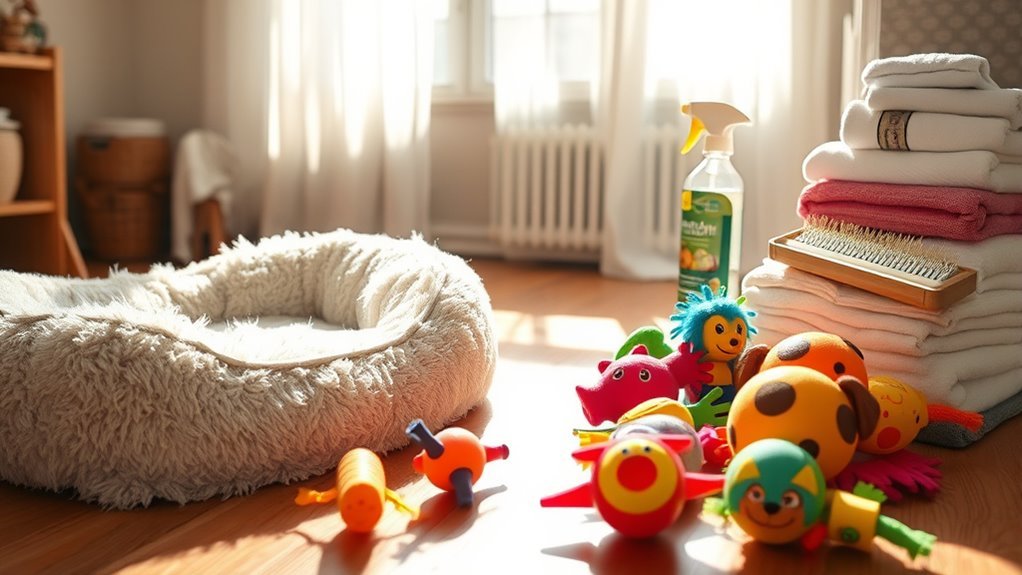
Keeping your pet’s bedding and toys clean is essential for their health and comfort, as well as for maintaining a hygienic home. Regular washing of bedding materials and proper toy sanitization prevents allergens, bacteria, and odors from taking hold. Choose washable bedding fabrics and use pet-safe detergents. For toys, scrub harder surfaces with warm soapy water and soak soft toys periodically.
| Task | Recommended Method |
|---|---|
| Bedding Materials | Machine wash, gentle cycle |
| Drying Bedding | Air dry or low heat dryer |
| Hard Toys Sanitization | Scrub with soap and water |
| Soft Toys | Soak in pet-safe disinfectant |
| Frequency | Weekly for bedding, biweekly for toys |
Managing Litter Box Cleanup and Maintenance
How often should you tackle litter box cleanup to guarantee your pet stays healthy and your home stays fresh? Ideally, scoop waste daily and change the litter completely once a week. Proper maintenance prevents odors and keeps your feline happy. Consider these tips for managing your litter box effectively:
- Choose the right litter box type—covered boxes contain mess but may trap odors; open boxes offer ventilation.
- Pay attention to litter box placement—keep it in a quiet, accessible spot away from food areas.
- Use unscented, clumping litter to simplify cleanup and reduce irritation.
Sticking to this routine grants you freedom from unpleasant smells and assures your pet’s comfort, making spring cleaning a breeze for both of you.
Preventing Future Pet Messes With Easy Habits
Maintaining a clean litter box is a great start, but preventing future messes requires developing simple, consistent habits. You can embrace preventative measures by integrating daily routines that keep your home fresh and your pet happy. Consistency brings freedom from stress and unexpected messes.
| Habit | Benefit |
|---|---|
| Regular litter scooping | Reduces odor & encourages use |
| Scheduled feeding times | Controls digestion & accidents |
| Daily pet grooming | Minimizes shedding and dirt |
| Designated play areas | Limits mess to controlled spots |
Safe Cleaning Products for Homes With Pets
Why should you be extra cautious when choosing cleaning products for a home with pets? Pets are naturally curious and may ingest or come into contact with residues, making toxic chemicals dangerous. To keep your furry friends safe while maintaining a clean space, consider these pet safe alternatives:
Pets explore with their noses and paws, so choose cleaning products that are safe and non-toxic to protect them.
- Opt for eco friendly cleaners that use natural ingredients, minimizing harmful toxins.
- Avoid products containing ammonia, bleach, or phenols, as they can cause irritation or poisoning.
- Test any new cleaner on a small area first to guarantee it doesn’t harm your pet’s skin or paws.
Frequently Asked Questions
How Often Should I Deep Clean My Pet’S Outdoor Play Area?
How often should you deep clean your pet’s outdoor play area to keep it safe and fresh? Ideally, you should schedule deep outdoor maintenance at least once every season. Seasonal cleaning helps prevent buildup of dirt, bacteria, and odors that can affect your pet’s health. If your pet spends a lot of time outside, you might need to deep clean more frequently. Staying consistent guarantees a clean, inviting space your pet will love.
Can Certain Pet Breeds Cause More Mess Than Others?
Yes, certain messy breeds do tend to create more mess than others due to breed differences in behavior and coat type. For example, playful, high-energy dogs like Labradors or Huskies can track in mud or shed heavily, making cleaning more frequent. Understanding these breed differences helps you prepare better and maintain your space with ease. You’re free to enjoy your pet without constant worry by tailoring your cleaning routine to their specific needs.
What Are Signs That My Pet’S Mess Indicates a Health Issue?
If you notice unusual behavior like lethargy, excessive scratching, or sudden dietary changes, it might signal a health issue behind your pet’s mess. Watch for persistent vomiting, diarrhea, or blood in urine or stool. These signs shouldn’t be ignored, as they can indicate infections or allergies. Trust your instincts—if your pet’s mess seems off, consult your vet promptly to keep your furry friend healthy and free to enjoy life fully.
How Do I Clean Pet Messes From Hardwood Floors Effectively?
You might think a quick wipe is enough, but effective cleaning techniques require more care to protect your hardwood floors. Start by gently blotting messes, then use a pH-neutral cleaner to avoid damage. Avoid harsh chemicals or excessive water that can warp wood. Regular hardwood maintenance means promptly addressing spills and using soft cloths or mops. This way, you preserve your floors’ beauty while enjoying the freedom of a pet-friendly home.
Are There Natural Remedies to Soothe My Pet’S Cleaning-Related Anxiety?
If your pet’s anxious from cleaning time, you can use natural remedies with calming scents like lavender or chamomile to promote anxiety relief. Try diffusing these essential oils or using sprays designed for pets, but always check for safety first. You might also create a cozy space with familiar blankets and toys. These simple steps help your pet stay calm, giving both of you the freedom to clean without stress.
